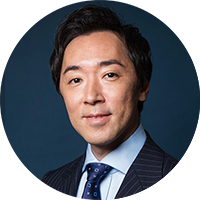Coach's VIEW is a business column authored by executive coaches in COACH A, aimed at providing valuable insights and effective approaches for leveraging coaching to foster organizational and leadership development. The column draws on the latest coaching trends and data, as well as insights from notable global publications on coaching.
Not Thinking, But Yielding

This past weekend, I had the opportunity to visit Kamikochi. I stayed in a small tent at the base of the mountains and experienced the chilly mornings and evenings. However, I also had the privilege of basking in the sun's warm rays, which revitalized my body. The river in Kamikochi is truly breathtaking, flowing freely and undisturbed. The mountains stand majestically, not trying to make a statement but simply existing.
Being in such an environment had a profound effect on me. It slowed down my typically hurried thoughts, allowing me to detach from memories of the past, as well as expectations and anxieties about the future. Instead, I found myself fully present, accepting and embracing everything that was right in front of me. It was a moment of surrendering myself to the beauty and tranquility of the surroundings.
The Burden of Overthinking: The Struggle of Modern Minds
Sometimes, it's only when we immerse ourselves in nature and our thoughts slow down that we, as modern individuals, realize the extent of our overthinking. This concept reminds me of a poignant line from the movie "The Way," where a deceased son tells his father during their pilgrimage on the Camino de Santiago: (*1)
"We don't choose our lives; we simply live them."
Questions about what constitutes a good life, how to make the right choices, what our purpose is, how to avoid danger, and how to gain acceptance constantly occupy our minds. We ponder these things each day. Many of us live our lives more focused on how our actions will be evaluated rather than on what we genuinely desire. Consequently, we strive to constantly improve ourselves to receive favorable evaluations. It seems that we are merely existing, with little space for us to truly live and be ourselves.
In my previous column, I delved into the concept of harmonizing the "mind," the "body," and the "heart." I referenced Yoshida Shoin(*2) and the Youmeigaku(*3) to illustrate this idea. While we associate the "mind" with thinking, it raises the question: What does the "heart" represent? Furthermore, if we release our attachment to constant thinking, what arises within us? What can be considered as the opposite of thought?
Exploring the Four Selves Within You
In one of my previous columns, I explored the concept of the left-brain self, characterized by analytical thoughts, and the right-brain self, associated with freedom and creativity. I drew inspiration from the work of Jill Bolt Taylor, a neuroscientist who personally experienced a stroke resulting in the temporary loss and subsequent restoration of left brain function. In her latest book, "Whole Brain," Taylor takes the discussion of the left-brain/right-brain divide even further, introducing four distinct categories: the thinking left brain, the feeling left brain, the feeling right brain, and the thinking right brain. (*4)
Thinking Left Brain(Character 1): This aspect governs logical thinking and orderly processing. It seeks to discern what is right and good, guiding us with purpose and careful deliberation.
Sensing Left Brain(Character 2): Responsible for sensing danger and triggering protective responses based on past memories. It communicates through fear and anxiety, directing attention to potential threats and prompting fight, flight, or freeze reactions.
Sensing Right Brain(Character 3): This self focuses on the present moment, embracing the holistic perspective. It seeks enjoyment, pleasure, and thrilling experiences. It fosters connections, empathy, and a sense of joy, gratitude, and awe.
Thinking Right Brain(Character 4): The Thinking Right Brain is elusive to access. It emerges when the other three selves become still. It accepts things as they are and opens awareness to the present moment without judgment or analysis.
Just Dive In: Embracing Change and Taking Action
During his first long vacation in a decade, a busy client from a major consulting firm found himself in Zermatt, Switzerland, at the base of the majestic Matterhorn. The moment he laid eyes on the breathtaking scenery, he sensed a profound connection with his inner self. Realizing he had been overthinking and carrying too much on his shoulders, he decided to approach life with a lighter perspective, seeing the challenges he faced as amusing anecdotes.
When the story of the four brain characters was shared with him, he reflected on his own condition. "Typically, Character 1, representing logical thinking and busyness, dominated my every waking hour, occasionally triggering the anxious Character 2. However, during this trip, I consciously chose to detach from work entirely. As a result, Character 3, the self that embraces the present moment and seeks enjoyment, took the lead. The noisy Character 2 and busy Character 1 quieted down, making space for the emergence of Character 4, the self that accepts things as they are and opens awareness without judgment."
Returning from his journey, he experienced a significant shift in his mindset. Previously, he often focused on what he needed to do to achieve his goals. Now, he possessed a newfound clarity and a proactive attitude. He knew precisely what steps to take, and without hesitation, he jumped right into action.
Beyond Thoughts: Embracing the Power of the Thinking Right Brain
When we talk about "thinking," we often refer to the dominance of the "thinking left brain (Character 1)." This aspect of our brain processes information in a logical and orderly manner, taking the lead when we engage in daily tasks. It works alongside the "sensing left brain (Character 2)," which receives external information and allows Character 1 to analyze and make sense of it.
However, there are moments when true readiness and preparedness go beyond conscious thought. Instead of trying to control everything, some individuals, including clients and leaders, trust themselves, others, and their teams, surrendering to a different kind of knowledge. This may be the voice of the "thinking right brain (Character 4)" emerging, which recognizes existence itself as a miracle and embraces the constant state of change.
By acknowledging these four characters within us and taking the time to reflect on their presence, we can gain a fresh perspective on our daily work. It calls us to embrace change, to step into unexplored territories. Many clients express a desire to find their own guiding principles in this journey. Perhaps it is in such a space that we transcend mere thinking and achieve harmony among our thoughts, emotions, and physical being.
When do you personally experience the emergence of the "thinking right brain (Character 4)" within yourself?
【REFERENCE】
*1 Yoshida Shoin (1830-1859) was a prominent figure in Japan's late Edo period. He was a philosopher, educator, and political activist who played a significant role in shaping the intellectual and political landscape of Japan during that time.
*2 Yōmeigaku, or the "Yōmei School," is a philosophical and ideological tradition in Japan based on the teachings of Wang Yangming, a philosopher from the Ming dynasty in China (1527-1598). Yōmeigaku emphasizes subjective inner intuition and the voice of conscience, promoting the concept of "unity of knowledge and action."
*3 『THE WAY』, a drama film co-produced by the United States and Spain in 2010.
*4 『WHOLE BRAIN』written by Jill Bold Taylor, Kaoru Takeuchi (translator) by NHK publisher, 2022
*Regardless of profit, non-profit or intranet, secondary use such as copying, diversion, selling etc. is prohibited without permission.
Language: Japanese

